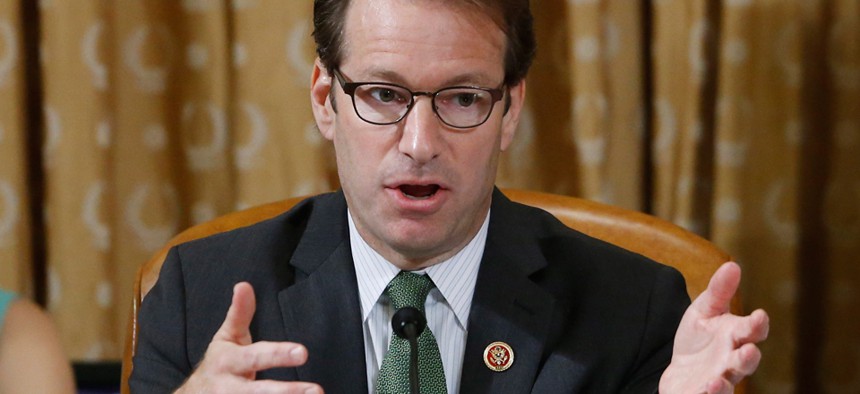
Rep. Peter Roskam, R-Ill. Charles Dharapak/AP file photo
House Republicans Are Stepping Up Efforts to Attach Special Policy Riders to Spending Bills
Last year one such provision cut EPA staffing to the lowest levels since 1989.
In a recent memo to lawmakers, House Republican leaders ticked off some of their lesser-known victories in the fiscal 2014 appropriations process. A prohibition on funding for the renovation of United Nations headquarters in New York made the list. So did a measure prohibiting the Energy Department from halting the production of incandescent light bulbs.
Now, as a new appropriations process begins, they hope to do it again, though perhaps this time on a larger scale.
Republicans are stepping up efforts to insert special provisions—including some that are partisan or ideological—into fiscal 2015 appropriations bills, according to memos from Republican House leaders. And Democrats will be doing the same. The measures could impact funding in areas ranging from abortion and the environment to U.N. activities.
Republican lawmakers have been encouraged by leaders to consider next week's House votes on the Military Construction and Veterans Affairs as well as the Legislative Branch appropriations bills as the beginning of an "opportunity" to enact conservative policies through policy riders, many of which couldn't pass as stand-alone bills.
The two bills are the first of a dozen annual spending measures due for completion by the start of the new fiscal year Oct. 1. Neither has traditionally been a vehicle for more-controversial policy amendments, but later bills are expected to include stronger efforts.
"We view the appropriations process much differently than in years past," says a memo to Republicans from David Mork, chief of staff to Rep. Peter Roskam, the chief deputy whip for the House GOP.
The two-year budget deal reached in December set top-line spending for 2015 at $1.014 trillion and allowed a more traditional appropriations process in which committees consider proposals and amendments.
"The advantage this presents for us is greater opportunity to influence the priorities and policies that will be included," the memo said.
Of course, not everything inserted in the House will make it through the Senate, and vice versa. And lawmakers may not even pass 12 separate bills, opting instead for omnibus legislation.
But a hint of the efforts that might lie ahead was spelled out in a separate document from Roskam's office, which proclaimed, "There were a host of policy wins achieved through the FY14 appropriations process that serve as a foundation and example for what we can begin to work on for FY15."
Among the provisions listed as victories are a series of antiabortion measures inserted into at least four different appropriations bills; a provision exempting livestock producers from the Environmental Protection Agency's greenhouse-gas regulations; a prohibition on any funding being used to transfer Guantanamo Bay detainees to the United States and for construction or acquisition of a prison in the U.S. to house such detainees; and a reduction in EPA staffing to the lowest levels since 1989. It also cited the provisions concerning the U.N. and the incandescent bulb.
"The member request database is now open," the memo says, inviting proposals for policy riders from GOP lawmakers.
In fact, Congress has been tacking policy riders onto appropriations bills since the 1870s—and they've been controversial almost from the beginning, often used as a backdoor way to tie the hands of a president and his administration. Assistance to rebels in Nicaragua, military activities in Southeast Asia, air bags for autos, and religious activities in schools are among the areas affected by such bills over the years.
Steve Ellis, vice president of Taxpayers for Common Sense, said riders can sometimes be targeted at admirable goals and even save taxpayers money. But he said they are designed to be slipped into must-pass legislation, without giving watchdogs or the public much chance at evaluation. "Because they're often controversial and would just get stripped out—they are intended to go under the radar, be invisible," Ellis said.
By contrast, one of the bigger fights already shaping up over policy riders is taking shape very publicly. Democratic Reps. Mike Thompson and Elizabeth Esty, vice chairs of the House Gun Violence Prevention Task Force, sent a letter last month urging House Speaker John Boehner and Minority Leader Nancy Pelosi to reject riders that block efforts to prevent gun violence. The letter was signed by 106 lawmakers.
Gun-related riders, they complained, "prevent the Centers for Disease Control and the National Institutes of Health from conducting research on the causes of gun violence. They restrict law enforcement's ability to track and combat the spread of illegal guns. And they harm efforts to reduce and prevent gun violence."
They added: "The American people deserve an open debate on these backdoor legislative tactics that do nothing but make our communities less safe."
Of course, how policy riders will fare in the 2015 process is still unclear, as is whether Congress can actually complete 12 spending bills. The two 2015 appropriations bills now written and set for a vote next week both include several riders, though nothing controversial has surfaced yet.
For instance, The MilCon-VA bill includes a direction limiting "the use of funds for publicity of propaganda designed to support or defeat legislation pending before Congress." And the Legislative Branch bill includes a prohibition on funds used by the Congressional Research Service "to publish or prepare material to be issued by the Library of Congress unless approved by the appropriate committees."
The price tag of the Legislative Branch bill, which would continue the salary freeze for Congress in place since 2010, is described by the Appropriations Committee as $3.3 billion (excluding Senate-only items). This is the same as the fiscal 2014 level, and it is $122.5 million below the president's request.
The MilCon-VA bill provides $71.5 billion in discretionary funding, which is $1.8 billion below the 2014 level. While it provides less funding for military construction, it increases funding to veterans programs by $1.5 billion.







